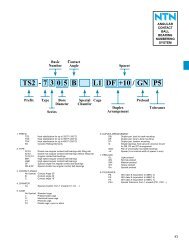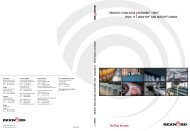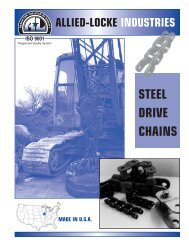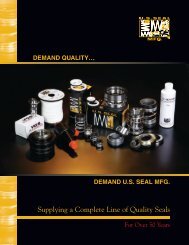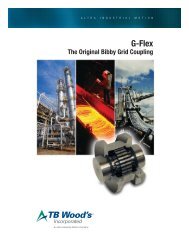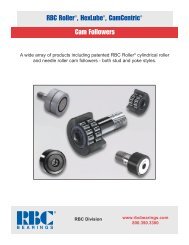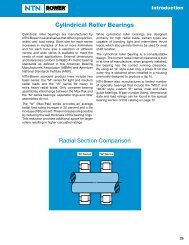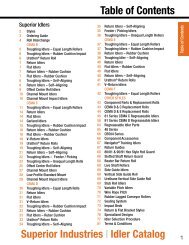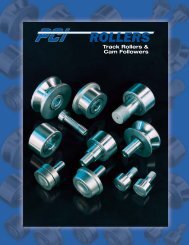Rex Linkbelt Roller Chain Catalog - Norfolkbearings.com
Rex Linkbelt Roller Chain Catalog - Norfolkbearings.com
Rex Linkbelt Roller Chain Catalog - Norfolkbearings.com
- No tags were found...
Create successful ePaper yourself
Turn your PDF publications into a flip-book with our unique Google optimized e-Paper software.
<strong>Roller</strong> chain selection procedure (cont.)Determine the minimum conveyor strength required• Multiply the working factor by the approximate conveyorpull. The product is the minimum ultimate conveyor strengthrequired.Determine the minimum chain strength required • Dividethe minimum conveyor strength by the number of strandscarrying the load.When the conveyor is designed to use two or more parallelstrands of chain the required chain strength should reflect thedistribution of load on each strand. If equal load distributionis assured, base the required chain strength for double strandconveyors on 1 / 2the minimum conveyor strength requirement,1/ 3for triple strand, etc. If the strands are not evenly loaded,divide the calculated minimum conveyor requirement by thenumber of strands that will normally handle the imposed load.For example, the chain selected for a four-strand conveyor mayhave to be based on two or three strands taking the full load attimes, due to its distribution on the conveyor.Select the conveyor chain • Refer to Table 6 on page E-4and select a chain with an ultimate strength slightly greater thanthe minimum requirement just calculated.The size of slats or pans, or the required spacing ofattachments govern chain pitch. Make sure that the chainselected meets both pitch and strength requirements.Check the chain selection • Refer to the formula previouslyused and <strong>com</strong>pute the actual chain pull, considering chainweight (Table 6 on page E-4 ) and takeup tension now that achain has been selected.Multiply the actual chain pull by the working factor to determinethe minimum ultimate strength requirement. Check the resultagainst the ultimate strength of the chain selected. If equal toor greater than the minimum requirement, the chain selection issatisfactory.Determine the number of teeth in the sprockets • Usesprocket pitch diameters listed for drive series Double Pitchchains (pages E-10 through E-23) for determining the numberof teeth in the desired sprocket for use with conveyor seriesextended pitch chains.If possible, use sprockets with 15 teeth or more. Smoothness ofconveyor chain operation is dependent upon adequate teeth inthe driving sprockets, as illustrated in Chart A, page E-2.Calculate chain length and sprocket centers • When thenumber of teeth in the sprockets is equal, calculate chain lengthfrom the formula:chain length, in pitches= T + 2cPwhere c = center distance between shafts, inchesP = chain pitch, inchesT = number of teeth per sprocket<strong>Chain</strong> length should equal an even number of pitches. Using thenearest even number of pitches as value N, calculate the exactsprocket centers from the formula:C = N – T × P2where C = exact sprocket centers, inchesN = nearest even number of pitchesP = chain pitch, inchesT = number of teeth per sprocketWhen the number of teeth in the head and foot sprockets isunequal, chain length and exact sprocket centers are calculatedfrom the formula on page C-8.<strong>Chain</strong> sag • The amount of sag in the slack span of chain iscalculated from the formula on page E-2.Lubrication • It is usually advisable to lubricate conveyorchains. See page E-9 for methods and re<strong>com</strong>mendations.Calculate the conveyor horsepower requirement • Tocalculate the horsepower required to operate the conveyor,use the formula in the appropriate conveyor layout, pages E-6and E-7.55EE-5




